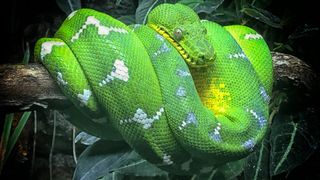
How long do new species take to evolve?
New species can form astonishingly quickly — or the process can take eons.

Charles Darwin famously marveled at the "endless forms most beautiful and most wonderful" produced by evolution, and indeed, Earth today teems with an estimated 1 trillion species. But how long did it take those species to evolve?
The answer varies widely across lifeforms, "depending on taxa [type of creature] and environmental conditions," Thomas Smith, a professor of ecology and evolutionary biology at the University of California, Los Angeles, told Live Science. It ranges from human-observable timescales to tens of millions of years.
Crucially, because evolution happens via inherited changes, a creature's speed of reproduction, or generation time, limits the rate at which new species can form — known as speciation rate — according to the University of California, Santa Barbara (UCSB). For example, because bacteria reproduce so quickly, "split[ing] in two every few minutes or hours," they can evolve into new varieties in years or even days, according to the American Museum of Natural History in New York City.
It can be tricky, however, to determine which bacterial varieties count as new species, Smith said. While scientists delineate species by whether they can interbreed, bacteria do not reproduce sexually. Nevertheless, a 2008 study in the journal Proceedings of the National Academy of Sciences reported that a lineage of E. coli bacteria observed for decades had evolved the ability to use citrate as a food source in an oxygenated environment. Because the inability do this is "a defining characteristic of E. coli as a species," the change could represent the beginnings of a new species, researchers said — one that developed within a few years.
Related: How long do most species last before going extinct?
Plants, in a phenomenon known as polyploidy, can duplicate their entire genomes in seeds, resulting in additional copies of every chromosome and a new species in one generation. The resulting reproductive isolation "automatically makes a new species," Smith said.
And because many plants reproduce by themselves, the new, polyploid organism can go on to create more of the new species. "Plants are often self-fertilizing, so it can then start a whole population," UCSB said.
Sign up for the Live Science daily newsletter now
Get the world’s most fascinating discoveries delivered straight to your inbox.
Even in the animal kingdom, speciation can happen on human-observable timescales, particularly among quick-generating insects. Apple maggot flies (Rhagoletis pomonella), for example, historically fed on hawthorn plants, but some moved to domesticated apples after these arrived in the Northeast U.S. in the mid-1800s. Since then, the two groups have become reproductively isolated, according to a 2006 study in the journal Annals of the Entomological Society of America, and are now considered "host races"— the first step in a type of speciation without physical barriers.
Speciation generally moves more slowly in vertebrates but can still happen quickly. A 2017 study in the journal Science reported that a Galapagos finch immigrated to a new island and bred with a native bird, producing a new reproductively isolated lineage within three generations. That lineage may represent the very fast initiation of speciation via hybridization of species, rather than the slower accumulation of adaptations, study co-author Leif Andersson, a geneticist at Uppsala University in Sweden, told Live Science.
"This is a possible scenario of how a new species can form," Andersson said. "But then how stable it is over a longer period of time is more uncertain."
Speed limits

The speed record for full speciation among vertebrates likely belongs to cichlid fishes in Africa's Lake Victoria, Smith said. These fishes exploded into 300 species "from a single founder less than 12,000 years ago," he said. Some research, such as a 2000 study in the journal Proceedings of the Royal Society B, has questioned that timeline, but cichlid speciation "is extraordinary," Smith said.
To find an upper limit for speciation times, look to speciation that occurs because of physical barriers, Smith said. For instance, boas, primarily found in the Americas, and pythons, which are native to Africa and Asia, differentiated after South America split from Africa. This likely represents tens of millions to 100 million years from continental split to full speciation, Smith said. (These snakes' last common ancestor slithered roughly 70 million years ago during the dinosaur age, according to Australia National University, while Africa and South America split by about 140 million years ago.)
Naming an average or most common speciation time is challenging, Andersson said, but scientists can estimate most recent ancestors, giving a rough idea. "In birds and mammals, what we see is that normally … a split between well-developed species is like a million years old," he said.
A 2015 study in the journal Molecular Biology and Evolution gave another estimate. Drawing on data from more than 50,000 species (though this included few bacteria), the researchers found that speciation generally requires the accumulation of mutations over 2 million years. This held true across vertebrates, arthropods (a group that includes insects, arachnids and crustaceans) and plants.
However, such models require many assumptions, other researchers cautioned in a Quanta Magazine story on the research. Scientists are on more solid footing regarding the factors that slow or speed speciation generally — namely environmental pressure and reproductive isolation, Smith said. "Across all species … the greater the selection pressure and the less gene flow, the more likely you're going to get speciation," he said.
Originally published on Live Science.

Michael Dhar is a science editor and writer based in Chicago. He has an MS in bioinformatics from NYU Tandon School of Engineering, an MA in English literature from Columbia University and a BA in English from the University of Iowa. He has written about health and science for Live Science, Scientific American, Space.com, The Fix, Earth.com and others and has edited for the American Medical Association and other organizations.
